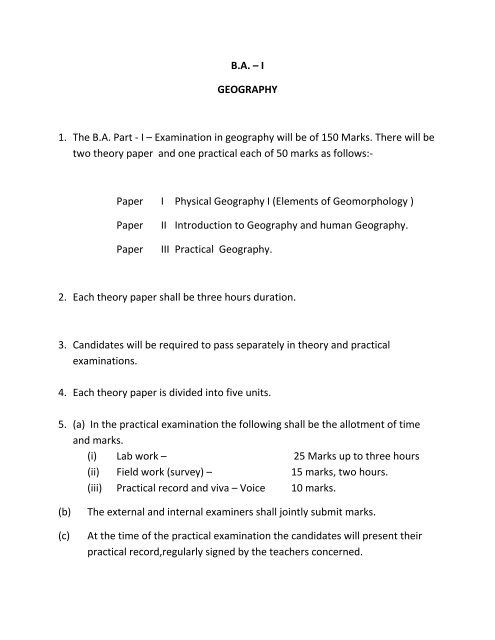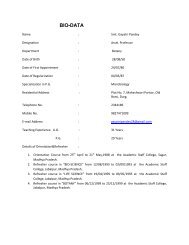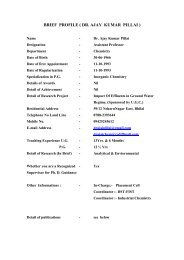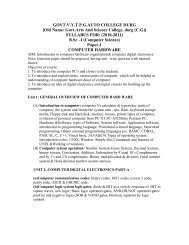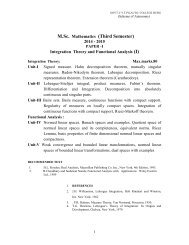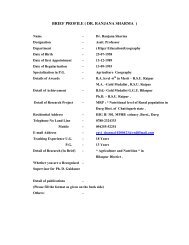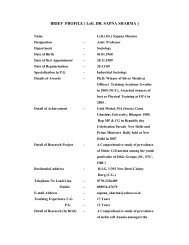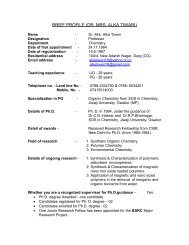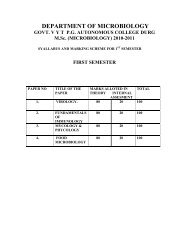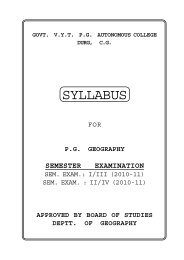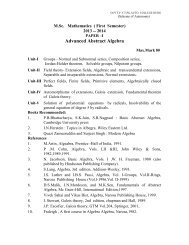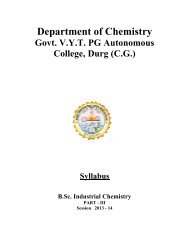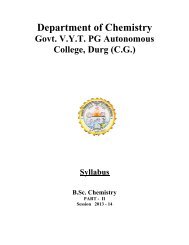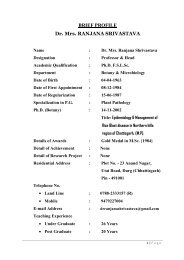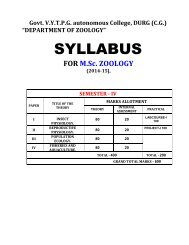SYLLABUS Geography 2013-14 - Govt. V.Y.T.PG. Autonomous ...
SYLLABUS Geography 2013-14 - Govt. V.Y.T.PG. Autonomous ...
SYLLABUS Geography 2013-14 - Govt. V.Y.T.PG. Autonomous ...
You also want an ePaper? Increase the reach of your titles
YUMPU automatically turns print PDFs into web optimized ePapers that Google loves.
B.A. – IGEOGRAPHY1. The B.A. Part - I – Examination in geography will be of 150 Marks. There will betwo theory paper and one practical each of 50 marks as follows:-Paper I Physical <strong>Geography</strong> I (Elements of Geomorphology )PaperPaperII Introduction to <strong>Geography</strong> and human <strong>Geography</strong>.III Practical <strong>Geography</strong>.2. Each theory paper shall be three hours duration.3. Candidates will be required to pass separately in theory and practicalexaminations.4. Each theory paper is divided into five units.5. (a) In the practical examination the following shall be the allotment of timeand marks.(i) Lab work – 25 Marks up to three hours(ii) Field work (survey) – 15 marks, two hours.(iii) Practical record and viva – Voice 10 marks.(b)(c)The external and internal examiners shall jointly submit marks.At the time of the practical examination the candidates will present theirpractical record,regularly signed by the teachers concerned.
<strong>Govt</strong>. V.Y.T.P.G <strong>Autonomous</strong> College Durg (C.G.)(Scheme of Autonomy)SESSION- <strong>2013</strong>-<strong>14</strong> Annual ExaminationCLASS- B.A. -IPaper no. - ITitle of the paper- Physical geography (Elements of geomorphology). Max Marks - 50Unit –IUnit – IIUnit – IIIUnit – IVUnit – V: The nature and scope of Physical <strong>Geography</strong>, interrelation of Physicalgeography with other branches of earth science. The place ofgeomorphology in Physical <strong>Geography</strong>, Geological time scale.: Earth interior, Vegnor’s theory of Continental Drift. Plate Tectonics.Earth movement :- Orogenic and Epeirogenic, Isostasy , Earthquaks andVolcanos.: Rocks - Origin and Composition of Rocks, weathering, formation ofregolith and soils, rocks and relief, geomorphic agents and processes –erosion, transportation and deposition of rocks, mass wasting.: Evolution of Landscape, concept of cycle of erosion, interruption of cycleof erosion. Fluvial and Glacial, karts and coastal landscape.: Applications of Geomorphology to hydrology, Mining, EngineeringWorks, Hazard management and Urbanization.
<strong>Govt</strong>. V.Y.T.P.G. <strong>Autonomous</strong> College Durg (C.G.)(Scheme of Autonomy)SESSION- <strong>2013</strong>-<strong>14</strong> Annual ExaminationCLASS- B.A. -IPaper no. - IITitle of the paper- Introduction to geography and human <strong>Geography</strong>. Max Marks - 50Unit – I : The nature of <strong>Geography</strong>, objective and relevance, Place of geographythe classification of Science, geography and other disciplines.Unit – II : geography as the studies of environment, man environmentrelationship, ecology and ecosystem, Environmental determinism,possibilism Neo-determinism ; Dualism in <strong>Geography</strong> – systematic \Regional, physical \ Human ,complementarilyUnit – III : Definition and Scope of Human <strong>Geography</strong>. Human Races – theircharacteristics and distribution. Human adaptation – to the environment;Eskimos, Bushman, Pigmy, Gond, Masai and Naga.Unit – IV: Growth of Population ; Distribution of population, World Distributionpattern – physical economic and social factors influencing spatialdistribution, concept of over population, under population and optimumpopulation, migration- internal and international, settlement – Types andPatterns of settlement.Unit – V : A brief historical overview of <strong>Geography</strong> as a discipline, recenttrends in geography with special reference to India, imperative for thefuture, career opportunities for Geographers.
PAPER – IIIPRACTICAL GEOGRAPHYCARTOGRAPHY AND STATISTICAL METHODSM.M. : 50SECTION – A M.M. : 251. : Scale-Plane, Time, Diagonal and Comparative.2. : Methods of showing relief-hachure, contours; representation of different landforms by contours, Drawing of profiles – serial, superimposed, projected andcomposite.3. : Line graph & Bar graph (simple & compound)4. : Circle Diagram, Pie Diagram, Wind rose.5. : Population pyramid.6. : Mean, Median and Mode.SECTION – BChain and Tap survey M.M. : 15Practical record and viva- Voice M.M. : 10
<strong>Govt</strong>. V.Y.T.P.G. <strong>Autonomous</strong> College Durg (C.G.)(Scheme of Autonomy)SESSION- <strong>2013</strong>-<strong>14</strong> Annual ExaminationCLASS- B.A. - IIPaper no. - ITitle of the paper- Physical geography (Climatology & Oceanography) Max Marks - 50A. CLIMATOLOGY ;Unit – IUnit – IIUnit – IIIWeathers and climate; definition and significance of climatology, Elements ofweather and climate; causes, Composition and structure of the atmosphere.Atmospheric Temperature; insolation and Global energy Budget, vertical, horizontaland seasonal distribution of temperature. Atmospheric pressure and winds: Verticaland Horizontal distribution of pressure ; planetary, periodic and local winds.Atmospheric moisture : humidity, evaporation and condensation ; Hydrologicalcycle; type of precipitation, world patterns of rainfall: regional and seasonaldistribution. Atmospheric disturbance: tropical and temperate cyclone;thunderstorm and tornados.Climatic classification, basis of Koppen’s classification and type distribution,characteristic and related plant and animal life. Role of climate in human life:Atmospheric pollution and global warming, general causes, consequence andmeasures of control.B. OCEANOGRAPHYUnit – IVUnit – VRelevance of oceanography in earth and atmospheric science. Definition ofoceanography, Surface configuration of the ocean-floor, continental shalf,continental slope, abyssal plain, mid-oceanic ridge and oceanic trenches; Relief ofAtlantic, Pacific and Indian oceans, distribution of temperature & salinity of Oceansand Sea.Circulation of oceanic water; Waves, Tides, and Currents, Currents of the Atlantic,Pacific and Indian ocean as store hours of resources for the future.
READINGS –CLIMATOLOGY1. Berry, R.G. & Chorley, R.J. Atmosphere, Weather and Climate, Routledge, 1998.2. Critchfield,H. : General : Climatology; prontice-Hall,New Yark 19753. Das,P.K. The Monsoons, National Book trust, New Delhi 1968.4. Lydolph, Paul, E. ; The Climate of the Earth, Roman and Allanheld, Totowa______1985.5. Mather, J.R., : Climatology, Mograw- nhill, New Yark, 1974.6. Pattarson,S. Introduction of meterology, MoGrowHill Book Co. ; London, 1969.7. Stringer, E.T. ;Foundation of Climatology. Surjeet publication, Delhi 1982.8. Trewertha, G.T., An Introduction to Climate : International Students edition, C.GrawHill,New Yark, 1980.OCEANOGRAPHY1. Anikouchine, W.A. and Sternberg, R.W.; The world Oceans an introduction to Oceanography,Englewood Cliffs; N.J. 1973.2. Grald, S. General Oceanography an Introduction, Johnwiley & sons, New York 1980.3. Garrison, T. Oceanography; Wordsworth. USA 1998.4. King C.A.M. Benches and Costs, E. Arnold, London, 1972.5. King C.A.M. Oceanography for geographers, E. Arnold, London, 1972.6. Sharma. R.C. Vatel M. Oceanography for geographers; Chetnya publishing house, Allahabad, 1970.7. Shepard, F.P. ; Submarine Geology, Harper & sons, New York 1948.8. Thurman, H.B. Introductory, Oceanography Charles webber E. Marril Publishing Co. , 1984.9. Weisberg, J. and Howard : Introductory Oceanography, MoGraw-Hill Book Co. , New York, 1976.
<strong>Govt</strong>. V.Y.T.P.G. <strong>Autonomous</strong> College Durg (C.G.)(Scheme of Autonomy)SESSION- <strong>2013</strong>-<strong>14</strong> Annual ExaminationCLASS- B.A. -IIPaper no. - IITitle of the paper- Regional geography with special reference to North America. Max. Marks - 50Unit - IUnit – IIUnit – IIIUnit – IVUnite – VRegional Concept; Bases of regionalization; North America, relief climate and soils.Forests, distribution and Production of Mineral and Energy Resources (Iron ore,Manganese, Copper, Coal, Petroleum and Hydro-electricity) of North America.Major Crops: Agriculture belts, Live stock and Dairy Farming in North America.Industries of North America- Location, Development & Production (Iron & SteelCotton Textiles, Heavy Engineering Industries), Industrial Regions, Population Tradeand Transport.Detailed study of the following regions of North America: California valley, NewEngland Region, Lake Region, Alaska, Prairie Region and St. Lawrence valley.
PAPER – IIIPRACTICAL GEOGRAPHYUnit – IUnit – IIUnit – IIIUnit – IVUnit – VDistribution Map : Dot, Choropleth & Isopleth.Map Projection: Definition and classification, Cylindrical Projection- Simple, equalArea, Gall’s , Marcator’s.Interpretation of weather maps: Use of metrological instrument.Statistical Methods: Quartile; Mean deviation , Standard deviation and Quartiledeviation ; Relative variability and co-efficient of variation.Surveying Prismatic Compass Survey: open and closed traverse, correction ofbearing , calculation of interior angles.
B.A. - IIIGEOGRAPHY1. : The B.A. Part III examination in <strong>Geography</strong> will be of 150 marks. There will be two Theory papersand one practical each of 50 marks as follows :-Paper – I Resources and EnvironmentPaper – II <strong>Geography</strong> of India (with special reference to Chhattisgarh)Paper – III Practical <strong>Geography</strong>.2 : Each theory paper shall be of three hours duration.3 : Candidates will be required to pass separately in theory and practical examinations.4 : Each theory paper is divided into Five Units.5 : (a) In the practical examination, the following shall be the allotment of time and marks.(i) Lab work 25 Marks up to three hours.(ii) Field work 15 Marks Two hours.(iii) Practical record and Viva 10 Marks.(b) The external and internal examiners shall jointly submit marks.(c) The candidates shall present at the time of the practical examination their practicalrecords, regularly signed by the teachers concerned.
<strong>Govt</strong>. V.Y.T.P.G. <strong>Autonomous</strong> College Durg (C.G.)(Scheme of Autonomy)SESSION- <strong>2013</strong>-<strong>14</strong> Annual ExaminationCLASS- B.A. -IIIPaper no. - ITitle of the paper- Resource and Environment Max Marks - 50A. RESOURCESUnit – I meaning, nature and components of resources and environment. Resources andenvironment interface, classification of Resources: renewable and non-renewable : biotic(forest wild life, live stock, fisheries. Agricultural crops) and abiotic (land water, mineral)Unit – II Distribution and utilization of water mineral and energy resources, their economic andenvironmental significance and Conservation, Type and distribution of forest, flora, faunaand fisheries, their economic and environmental significance and Conservation major soiltypes and their distribution; problems of soil erosion and soil conservation.Unit –III Number, density, growth and distribution of population pressure and resources utilization.B. ENVIRONMENTUnit –IVUnit – VClassification of environment: Nature and Human, man environment interrelation withrespect to population size, types of economy and technology: exploitation of naturalresources and environmental hazards.Emerging environmental issues- population explosion, food security: deforestation; globalwarming, conservation of bio-diversity, sustainable development.
<strong>Govt</strong>. V.Y.T.<strong>PG</strong> <strong>Autonomous</strong> College Durg (C.G.)(Scheme of Autonomy)SESSION- <strong>2013</strong>-<strong>14</strong> Annual ExaminationCLASS- B.A. –IIIPaper no. - IITitle of the paper- <strong>Geography</strong> of India (With special reference to Chhattisgarh). Max Marks - 50Unit – IUnit – IIUnit – IIIUnit – IVUnit – VPhysical features; structure, relief and physiographic regions, Drainage, Climateorigin and mechanism of Monsoon and regional and seasonal variation.Natural resources: Soils-Types their distribution and characteristics. Waterresources (major irrigation and hydro power projects), Forests – types, distributioneconomic significance and conservation, mineral and power resources – Iron-ore,Manganese, Copper, Coal, Petroleum and Natural gas, Non conventional sources ofenergy.Cultural features; Agricultural – Major crops impacts of Green revolution andagricultural regions, Industries – Iron and Steel, Cotton, Textiles, Cement, sugar.Population –growth and density and distribution. Transport, Foreign trades.Chhattisgarh: physical features: structure, Physiography. Drainage, Climate, Soils,Natural Vegetation, Water resources – availability and development, mineral andpower resources, Power projects.Chhattisgarh:Cultural feature ; Agriculture, Industries, Population-growth, distribution anddensity, Social groups, Literacy and Sex-ratio, urbanization. Major tribes - theirhabitat, economy and society. Transport and tourism.SUGGESTED READING :-1. Sharma, T.C. and Coutinho, O, Economic and Commercial <strong>Geography</strong> of India. Vikaspub, House, New Delhi, 1988.2. Singh, R.L.(Ed) ; India ; A Regional <strong>Geography</strong>, Nat. Geog. Soc. of India, Varanasi,1971.3. Spate, O.H.K. and Learnmonth, A.T.A. India and Pakistan : A general and Regional<strong>Geography</strong>, Methuen & Co. Ltd. London, 1967.4. Tiwari, R.C. <strong>Geography</strong> of India. Prayag Pustak Bhawart. Allahabad, 2003.5. Ikzkzehyk dqekj ¼lEiknd½ % e/;izns’k dk izknsf’kd Hkwxksy] e-izeiz- fgUnh xzaFk vdkneh] Hkksiky –
PAPER – IIIPRACTICAL GEOGROPHYM.M. : 50Unit – IUnit – IIUnit – IIIUnit –IVUnit –VBand graph, Hythergarph and Climograph, Square root and vernier scales.Map Projection; conical projection, one standard parallel, two standard parallels.Bonne’s ployconic, polar Zenithal projection; Gnomonic, Stereographic andOrthographic.Study and interpretation of Indian Topographical sheet: Classification and numberingsystem, interpretation of Indian Topographical sheet with respect to Cultural andPhysical features.Surveying- Plane table survey, Basic Principles of Plane table. Surveying, Plane tablesurvey including interaction and resection.Importance of field work in <strong>Geography</strong>. Field Work and Field report : physical, socialand economic survey of a micro-region.SUGGESTED READING ;1. Gregory S: Statistical method and the Geographer. Longman S. London, 1983 <strong>Geography</strong>.2. Monkhouse, F.J. & Wilkinson, H.R. : Map and Diagram, Methuen, London, 1994.3. Singh, R.L. : Elements of Practical geography, Kalyani pub. , New Delhi.


